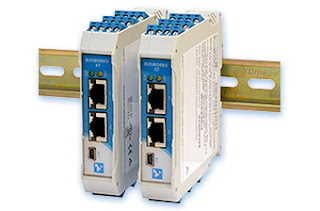 |
| Industrial Ethernet I/O Modules Courtesy Acromag |
- Point to point wiring from each measurement device to the control point.
- Wireless linkup from measurement location to controller.
- Wired network connection between measurement and control devices.
Each of these connection topologies has particular attributes which may better suit a particular application. For a wired network scheme, Acromag has designed a line of I/O modules that make installation and configuration a smooth operation. Helpful features include:
- Power wiring options that allow back connected bus power or top mounted screw terminals. You can even provide primary and backup power sources to the two connections.
- Front facing screw terminals for connections make status checking of inputs a simple operation with your digital volt meter.
- Modules are rail mounted and can be placed immediately adjacent to one another for high density installation.
- Modules have a built in webpage for display of operational information. Configuration is accomplished using a front mounted USB port.
- Operable in temperatures -40 to +70 deg. Celsius.
- Two Ethernet ports on each unit allow modules to be daisy chained, reducing or negating need for local hubs.
- Acromag's Priority Channel Technology assures that data update frequencies are maintained, regardless of other network traffic.
The short video below provides additional detail on the useful features of the Acromag line of industrial Ethernet I/O modules. Watch the video. Share your process measurement and control connectivity challenges with a sales engineer specializing in industrial Ethernet I/O. Combine your process knowledge with the state of the art product knowledge of a product specialist for the best solutions.
